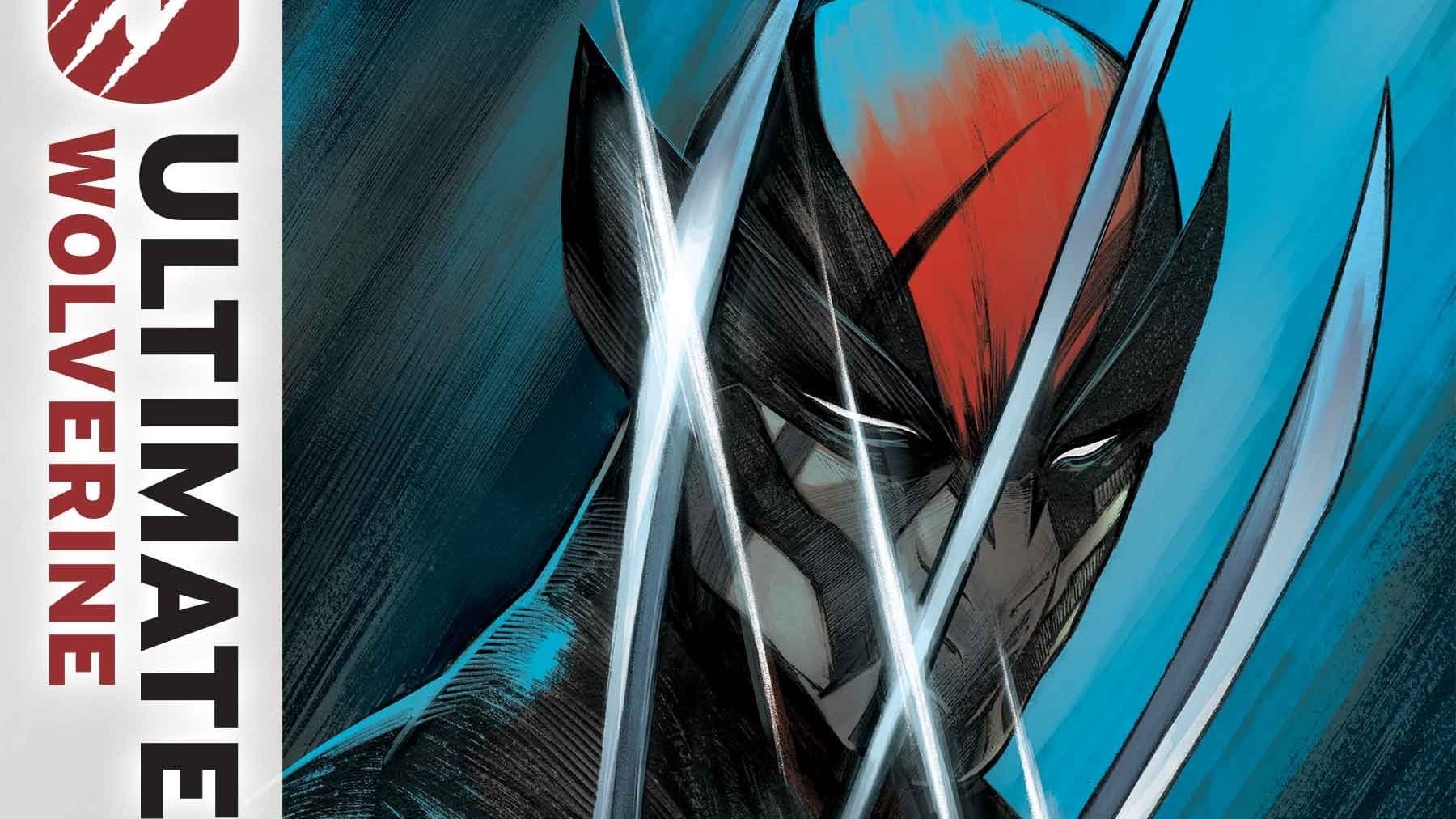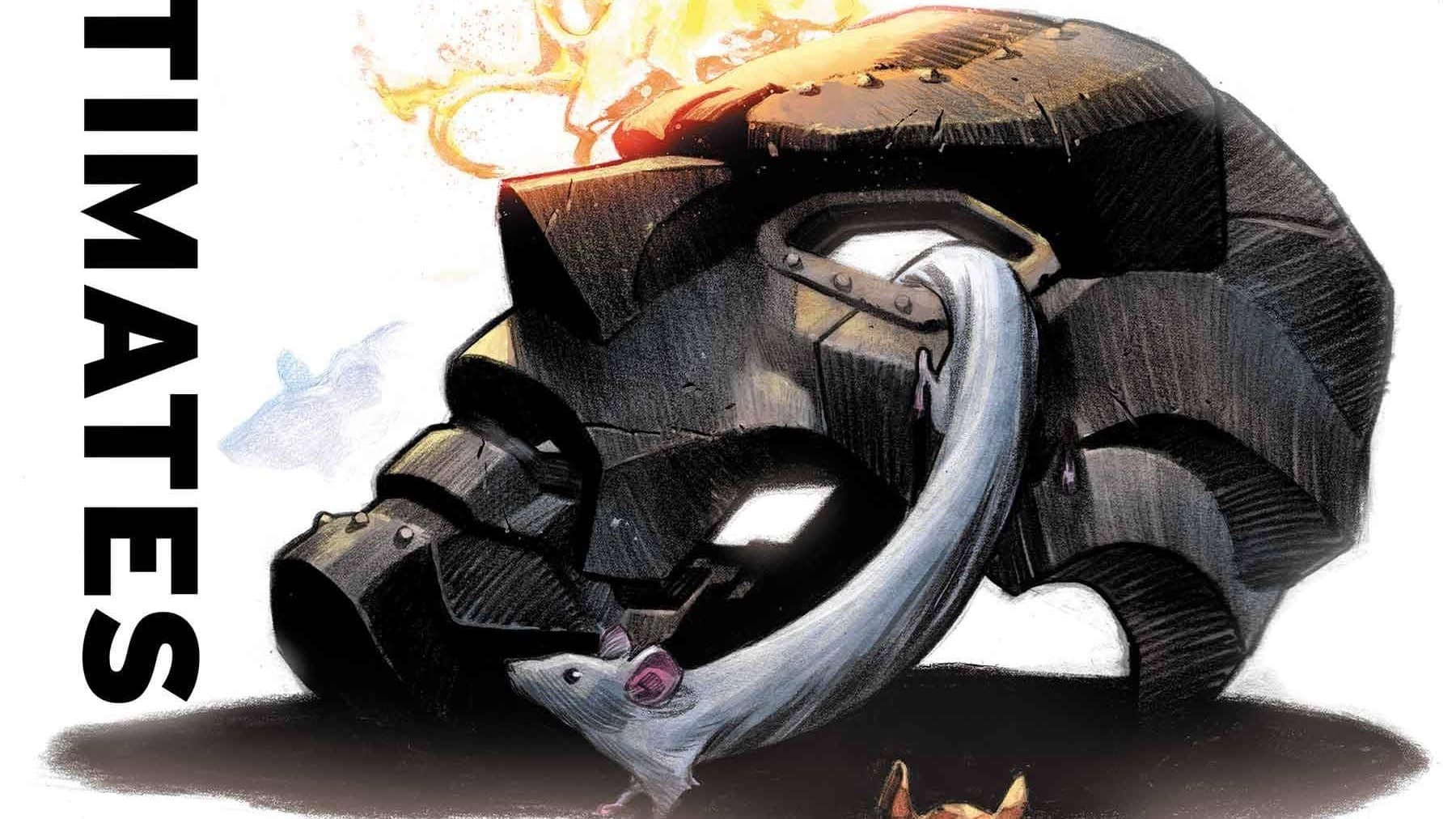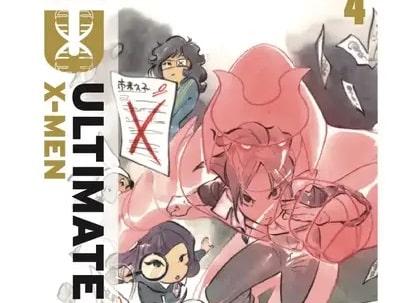To maintain control of their corner of the Maker’s world, three members of his council — Magik, Colossus and Omega Red — deploy their most lethal asset: the Winter Soldier! But who is the weapon behind the mask? Ultimate Wolverine #1 is written by Chris Condon, drawn by Alessandro Capuccio, colored by Bryan Valenza and lettered by Cory Petit.
Firstly, I say this as someone with all the love and admiration in the world for one of the preeminent characters in superhero comics: Such is the level of oversaturation of comics about this guy that my typical reaction to an announcement of a new Wolverine series is at best, “Hey, maybe this one will be a banger” and at worst, “Why do they put this motherfucker in everything? Where’s my 12-part prestige maxi Dani Moonstar series? I’m sick of this motherfu—”
Anyway, that wasn’t my reaction to Ultimate Wolverine. When the solicits first came out and that new design was announced, I was excited for three key reasons.
One: The Ultimate Universe under the stewardship of editor Wil Moss has proven to be fertile ground for a freer, more politically mature and experimental type of superhero comic.
Two: I’m a big Chris Condon fan. That Texas Blood exhibited his ability to write coherent and compelling fictional worlds, with relatable and complex characters and contemporary, chilling horror stories. His Ultimate Wolverine pitch promised a horror-fueled X-Men story, and with Wolverine in a Winter Soldier role, I couldn’t imagine a better fit.
Three: Alessandro Cappuccio. I fell in love with his moody, expressive and beautifully detailed art reading Moon Knight and again. What a perfect fit. On paper, I hypothesized, this could be good.
Was I right? Let’s inspect the specimen and find out.
Is it a missile? Is it debris? No, it’s Ultimate Ground Bear.

Here’s what you need to know about Earth-6160’s Wolverine. After the destruction of the North American Union by the Maker’s Council, the adamantium-infused “experiment gone wrong” made his way over to the Eurasian Republic to join the Opposition. A rebel force fighting the Republic, ruled with an iron fist by Colossus and supported by his deputies Magik and Omega Red, the Opposition (which includes Mystique and Nightcrawler, among others) lost their greatest asset and dear friend Logan to the other side. Captured, experimented on and mindwiped, the Republic unleashes their Winter Soldier on the Opposition, tearing through nameless soldiers and former friends indiscriminately.
While not a paradigm shift — this issue has echoes of “Weapon X” and other mind-controlled Wolverine stories — this issue is such a strong statement of intent. The tone and mood of this comic is what strikes me most. It didn’t focus too much on establishing future plots, but it drops you into a dark and murky world of secret ops and dictators where the first language is violence and it’s just so compelling. There are a couple of big choices Condon makes in the scripting that sets Ultimate Wolverine apart from most solo debut issues, especially origin stories. The first, and most striking, is for his lead character to remain silent throughout.
It goes further than that, though. There is no expository narration to guide the reader through the ins and outs of how this silent killer came to pass. Instead, Condon and Cappuccio develop Wolverine through other characters’ dialogue and through action. This means that characters and readers alike come to know him by reputation alone, which adds a layer of mystery and intrigue as to the person who lies beneath the mask that really works. The way Colossus’ council discuss him with Dr. Prostovich makes the character sympathetic immediately, such is the severity of dehumanizing language they use toward him.
They describe Wolverine as a “failed experiment,” a “useless specimen,” “wild”; Colossus and Magik refer to him as “it” (it’s interesting that Dr. Prostovich does not — this could be foreshadowing), and “our Winter Soldier” as they observe him from a place of safety. Condon was clearly inspired by Barry Windsor-Smith’s “Weapon X” here, and the tried and tested method of humanizing the hero by inflicting dehumanizing trauma upon them works, especially paired with the mythic way the regular soldiers describe him — the subject of legend, the man that can never die. For those for whom death is always an imminent possibility, you can see the appeal of such a figure.
Cappuccio’s art characterizes him brilliantly too, using a range of perspectives and panel compositions to cement this mythic quality. In the issue’s opening scene, Logan begins slouched in repose, eyes fixed dead ahead. As the soldiers on the plane begin to talk about him in fearful reverence, he slowly rises to his feet. Cappuccio frames the scene from the soldiers’ perspective as they fear for their lives as they meet the eyes of a killer. The final panel shows Logan bearing down on the reader, and it’s not until you take a closer look that you realize it’s not the soldiers he’s frozen his steely gaze onto, it’s the open hatch on the plane. Fear, pride, offense: These are not emotions Logan experiences. Life is the mission, nothing else. This is demonstrated most powerfully by the fact that Wolverine’s pose in the final scene mirrors the first, except it slowly zooms in on his eyes, as the reader is left to ponder the pain that lies behind them.
A wolf in the herd

The second great scene, and the most tragic of all, is when Logan faces off against his former comrades Nightcrawler and Mystique. The way Condon structures the reveal is great. He launches straight into a fight scene, through which he teases a vague sense of familiarity within Kurt before ending on the shocking and brutal crescendo of Mystique’s murder. Cappuccio absolutely kills it on these pages.
The scene then cuts away, before ramping the emotional turmoil and violence right back up again, as Kurt tries and fails to appeal to Wolverine’s humanity and their past affinity. The murder is brutal and sad, but not tragic. It’s given a certain coldness by the stillness with which Cappuccio draws Logan’s face. The tragedy comes later, when it’s revealed through flashback, and further through a letter from Kurt to Logan, that their close friendship was erased from Logan’s memory.
While our time with Ultimate Nightcrawler was brief, his legacy will undoubtedly live on in this series. His invocation of Psalm 23 (“The lord is my shepherd”) is the issue’s most impactful scene for me. Condon and Cappuccio combine to create a wonderful contrast between the animalistic brutality Wolverine visits upon his loved ones and a prayer for salvation. It appears initially that he’s praying for himself, but the repetition of the psalm’s opening refrains through narrative caption toward the end of the issue strongly suggests he’s praying for the salvation of his friend. The disconnect between Kurt’s language of peace and Logan’s violence is stark and, despite his violent end, it’s Kurt’s message of hope that shines through.
Cappuccio draws a panel that captures this message through an incredible piece of symbolism. Standing atop a pile of bodies, covered in the blood of his victims with claws crossed and baying for more blood, the light pours through the church windows, signifying the opportunity for his redemption regardless of the sins he’s being made to commit. Kurt’s death scene takes this a step further as he delivers a message of forgiveness: “If you’re in there, my friend, I pray you have the strength. … I’m sorry we weren’t quick enough.”
Listen, I’m not religious, but I find this really powerful stuff. It works in two ways for me. The first is that it evokes Logan’s relationship with Kurt and the discovery of his humanity in mainline X-Men continuity. The second is that the creative team really earn it.
A real human being

As the issue draws to a close and Wolverine is ostensibly placed back into cold storage, Cappuccio keeps his state of mind slightly ambiguous even when the mask is off. I believe we’re supposed to conclude that smelling his former comrade’s blood on his fingers is enough of a jolt to the memory to color the issue’s closing scene with a vague sense of melancholy. It suggests we are seeing growth, which begs the question as to where this series is going.
As well as having shades of “Weapon X,” the other stylistic reference I have for Wolverine in this issue is Nicolas Winding Refn’s Drive. The silent killer, driven in a seemingly emotionless manner by a singular purpose, constantly draped in shadow; the cold and calculated violence as an outward expression of the pain and that’s desperate to break forth — none of this directly applies to Wolverine yet, but my prediction is that it will. The way this is best expressed in Drive is actually through a song that appears on the soundtrack called “A Real Hero” by College and Electric Youth. It soundtracks Ryan Gosling’s character enjoying time with Carrie Mulligan’s character and her child as his life falls apart around him.
“Back against the wall at odds
With the strength of a will and a cause
Your pursuits are called outstanding
You’re emotionally complex
Against the grain of dystopic claims
Not the thoughts your actions entertain
And you have proved to be
A real human being and a real hero”
These lyrics beautifully express the notion of retaining or even rediscovering one’s humanity during times of severe hardship, and having the strength to fight one’s conditioning and for hope when all appears lost. I couldn’t help but hear this song in my head over the issue’s closing scene, as we look forward to what’s next for Logan. I’m all in.
Ultimately
- I’ll deal with Colossus, Magik and Omega Red, and the presentation of Russia generally, in future issues, but just a note to say that I noticed Condon writing in a Russian accent. The dropped definite and indefinite articles are a dead giveaway.
- Hopefully see you back here for issue #2, but in the meantime, I’ll be sat right here … ready for my next mission.
Buy Ultimate Wolverine #1 here. Disclaimer: As an Amazon Associate, ComicsXF may earn from qualifying purchases.
Jake Murray spends far too much time wondering if the New Mutants are OK. When he's not doing that, he can be found talking and writing about comics with anyone who will listen. Follow him @stealthisplanet.bsky.social.







